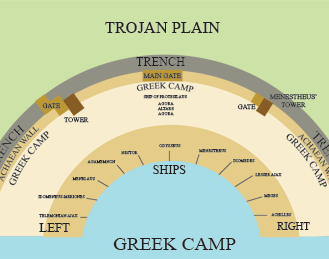|
INSTRUCTIONS
The Iliad interface consists of a 'timeline,' a text display area, a note box, and a 'stage' for the visual representation of actions described in the text. The labels on the stage offer a general orientation; clicking the 'labels on/off' button turns these labels on and off. [Click image to display interface.]

The stage displays 'actors' and their movements over the map. Grey vector-lines appear on the stage to indicate a positional change. Names are displayed in black, and distinct icons represent the actor type. Trojan actors are represented by triangular figures; Greek actors appear as figure-eights. Trojan actors are colored according to their columns in Book 12; Greek actors are colored according to the Trojan ranks they face in Book 12. Actors introduced later than Book 12 have their own colors to distinguish them from actors introduced previously. The colors of the actors in Book 17 are unique to that display and no longer correspond to the location of the Trojan ranks as they did in previous books.
The timeline has two associated navigation buttons with down and up arrow icons. The buttons allow traversal of the text by discrete jumps from event to event, forward and backward.
The timeline has a 'dragger' (diamond-shaped translucent bar). Mouse-over and click the bar to grab and drag down and up. Dragging the bar down and up moves the viewer forward and backward in the text. Moving the dragger all the way to the top resets the display.
The timeline displays events in the order narrated by Homer. An 'event' may consist of the action of any character or group of characters, human or divine, whether locomotion, dialogue, or battle. The events depicted on the interface are deemed to be essential to understanding Homer's use of space in his narrative and are selected for display on that basis. As a result, not every event in the narrative is highlighted, but only those significant events according to the spatial criteria.
Each event is indicated on the timeline by a horizontal red line. The position of the event on the timeline indicates the position of the event in the text of each book. The size of the gaps between the events displayed on the timeline corresponds to the number of verses that occur between the events. The gaps thus correspond to the amount of narrative elapsed between events; however, gaps are not intended to reflect the amount of time elapsed between events.
Red highlighted verses in the Greek and English texts correspond to the events indicated on the timeline and on the stage. Highlighted verses may precede the verses in which any given event is actually described. This is so especially in places where it is helpful to know the wider context of an event. The language of the text may be changed by clicking on the 'English' or 'Greek' buttons at the bottom of the display page.
The positions of the actors, Greek Camp, Troy, and the geographical features of the Trojan Plain reflect the interpretation set forth in Homer's Trojan Theater: Space, Vision and Memory in the Iliad by Jenny Strauss Clay (Cambridge University Press, 2011).
The schematic map of the Trojan Plain and the Greek Camp is adapted from B. Mannsperger, "Das Stadtbild von Troia in der Ilias," in Troia: Traum und Wirklichkeit (Darmstadt 2001) 81, and revised by Kim Dylla.
The English text is Lattimore's translation, used by permission of The University of Chicago Press; the Greek text is the Oxford Classical Text of Monro and Allen. The realization of this project is largely due to the expertise, hard work, and patience of Doug Ross of IATH and Courtney Evans and Ben Jasnow of the Classics Department of the University of Virginia.
This attempt to map the Iliadic Battle Books remains work in progress and will doubtless entail revisions. We welcome discussion, corrections, observations, and suggestions for improvements. Please Contact Us.
|